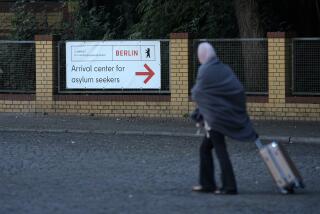E. Germans’ Exodus Spurs Move Toward Common Currency : Reunification: Officials are aiming for a monetary union that will restore the East’s economy without bankrupting the West.
- Share via
FRANKFURT, West Germany — Attempts to halt the flight of East Germans to the West have propelled the two Germanys toward monetary union at a rate that few had thought possible even a few weeks ago.
Now, some predict that monetary union will probably take place within a few months after East Germany’s March 18 parliamentary elections. If so, it could be the first major step in the reunification process.
The impact of plans to extend the West German currency, the deutschemark, to East Germany’s 16 million people has already spread beyond the two Germanys. International financial markets, unnerved by the speed of events, are concerned about the ability of one of the world’s most powerful currencies to withstand the strain.
But as with unification itself, a powerful mix of internal German political and economic realities fuels the move toward an all-German currency with a force that has swept technical arguments aside.
More than any other single factor, it is the lure of the highly valued deutschemark that brings East Germans into the West at the rate of 80 an hour. Anxieties among the jittery East Germans have also been stoked by dramatic West German assessments that the East German economy is on the verge of collapse.
“We must remain master of the political process,” West German Finance Minister Theo Waigel said recently when the world learned of his government’s decision to push for immediate monetary union. “The deutschemark has become the currency of choice for the people.”
Albert Juegel, an East German economist at Dresden’s Technical University, summed up the situation by saying, “What we need is real money.”
For the many East Germans who refer to their non-convertible currency as “aluminum chips,” the deutschemark represents much of what 40 years of Communist rule cheated them out of: wealth, stability, confidence and a freedom of choice.
“The plea for the deutschemark is more than just wanting the currency,” said Norbert Walter, chief economist of West Germany’s largest bank, the Deutsche Bank. “They see it as the anchor that can ensure political union.”
Oskar LaFontaine, deputy leader of the West German Social Democratic Party, was forced to remind his audience at the founding congress of the East German Social Democratic Party that the process of German unity is, above all, about the guarantee of human dignity and self-respect.
“The deutschemark isn’t everything,” he cautioned in remarks Feb. 23 in Leipzig.
But for East Germans, the disparity between their weak, unwanted ostmark and its powerful Western counterpart is one of the most constant, visible reminders of their economic plight.
There are indications that the current talks on monetary union could be a preview of the unification process itself--a process that many East Germans fear could quickly become more of a West German takeover than a carefully negotiated merger in which large portions of both systems survive.
Indeed, the process of bringing the deutschemark to East Germans is less a union of monetary interests than a deutschemark takeover.
Even at the negotiating table, there are signs that the East Germans are outgunned. The West German daily Frankfurter Allgemeine Zeitung noted that for the initial round of talks on the issue, Bonn sent three state secretaries and the Bundesbank vice president to face an East German team led by a mathematician and a Protestant clergyman.
Price reform, an end to massive subsidies and the start of a market economy in East Germany are basic conditions set by Bonn as part of any deal that would extend the deutschemark to the East. Such measures are almost certain to cause unemployment as East Germany’s overmanned, obsolete industries are forced to compete with the West.
West German bankers, whose views will play an important role in shaping the way East Germany is rebuilt, argue that the fastest way to create the confidence required for industrial and commercial investment in East Germany is to adapt West German law.
The rush to monetary unity began in January when the opposition Social Democrats in West Germany challenged the long-held wisdom that monetary union should be among the last steps on the road to unity.
Then, on Feb. 3, as the exodus from East Germany continued and concern mounted that the Social Democrats might be seen as seizing the initiative, Chancellor Helmut Kohl met East German Prime Minister Hans Modrow at an informal gathering of senior European leaders in Switzerland.
Modrow is believed to have given Kohl an exceptionally pessimistic view of the East German economy, apparently in the hope of getting a substantial amount of emergency aid.
Modrow failed to get the aid, and two days later, Kohl, after consulting with senior members of his coalition government, proposed negotiations on immediate monetary union.
The speed of the decision caught many people off guard. On the same day, unaware of his government’s policy reversal, Karl Otto Poehl, the highly respected president of the West German Bundesbank, described monetary union as premature. But less than 24 hours later, he came out of a West German Cabinet meeting in support of the idea.
The pace of the movement toward monetary union--and the unprecedented nature of what is proposed--have unsettled international financial markets. Never before has another currency been introduced into an industrialized economy at a time when it is trying to open itself to free-market competition.
As talks on monetary union began, nervous East Germans were twice panicked by rumors and proposals linked to the economic transformation.
There were reports that large East German savers might suffer disproportionately under terms of the union. Quickly, long lines formed outside banks as people rushed to divide their accounts into two or three separate accounts.
Then, the East German political opposition called for immediate removal of food subsidies, and this triggered panic buying in several cities.
Among the most sensitive issues under discussion by a joint commission are the rates at which East Germans will be allowed to exchange ostmarks for deutschemarks. For years, East German authorities have maintained an artificially high rate of 1 to 1, but tourists now can get 3 ostmarks for every deutschemark--double that on the East German black market.
Monetary union might involve different rates for different purposes, but a rate of 1 to 1 might be the best way to halt the flight of East Germans. On the other hand, it could set off an inflationary spiral that might endanger West Germany’s prosperity.
With an estimated 170 billion ostmarks in circulation, a 1-to-1 exchange rate would add about $100 billion--or about 14%--to the West German money supply. A lower rate, say 4 ostmarks to 1 deutschemark, would pose fewer dangers to the West German currency but could leave East Germans so dissatisfied that the flight of refugees would increase.
Disquiet about the planned currency union on international markets has been reflected in the reduced attraction for West German bonds. This irritates West German bankers, who are not accustomed to having the strength of their currency questioned.
West German financial experts, who calculate that the East German money supply is probably little more than a sixth of West Germany’s, argue that a currency union would not put an undue strain on the West German monetary system, particularly if the exchange rate is less than 1 to 1.
They say, too, that East Germany’s well-trained and eager work force, coupled with the prospect of massive West German investment, make the region a prime candidate for a second wirtschaftswunder-- or “economic miracle,” as West Germany’s recovery after World War II is known.
“This is all feasible without weakening the deutschemark,” economist Walter said. “If there is any change at all, I believe we’ll see the (deutsche) mark strengthen.”
He noted that West Germany, under a Draconian currency reform in 1948, exchanged new marks for old at a rate of 1 to 10, and that although unemployment doubled, it was this move that laid the groundwork for West Germany’s economic miracle.
A few days after his conversion to the idea of early monetary union, Bundesbank President Poehl said, “In the postwar period, we (in West Germany) went through a larger restructuring process, under far worse conditions.”
Toward A Single Deutschemark Plans to merge economies of the two Germanys face a number of obstacles. Among them: Fear-Making West Germany’s deutschemark the currency of both countries will amount to a takeoverby the far stronger deutschemark, and many East Germans are fearful of the result. Jobs-In the East, the merger would involve price reform, end to massive subsides and beginning of a market economy. Unemployment would almost certainly result. Market-Disquiet about the planned currency union on international markets has reduced demand for West German bonds. Exchange Rate-The eventual exchange rate is a sensitive issue. Retaining the artificially high rate of 1 ostmark to the deutschemark would suddenly pump about $100 billion into West Germany’s money supply. Applying a more realistic rate of about 4 to 1 would pose less risk but could leave East Germans dissatisfied with their buying power. The deutschemark is trading at about 59 U.S. cents
More to Read
Sign up for Essential California
The most important California stories and recommendations in your inbox every morning.
You may occasionally receive promotional content from the Los Angeles Times.













